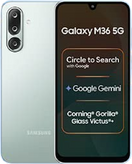Search Android Smartphones
Need an Android phone? In this overview you will find all popular Android smartphones that are for sale here. Due to the open character of Android, there is a suitable phone for every budget. Read more
Android is an operating system for mobile phones and tablets from Google. It is currently the most popular platform in terms of market share and is used by many manufacturers such as Samsung, Huawei and LG. With Android it's possible to download apps from an app store, with Android it's called the Google Play Store. There are now 2.7 million apps here (February 2017), free and paid.
Google announced the first public version of Android in 2009. Almost every year Google came up with an update using code names of desserts or delicacies. It runs through the alphabet even though the first consumer version started with a C; version 1.5 'Cupcake'. The letters A and B were skipped because those versions remained in beta. Since 2019 Android versions only have a version number.
Android versions
| Version | Code name | Launch date | New features | 1.5 | Cupcake | April 2008 | Bluetooth support |
|---|---|---|---|
| 1.6 | Donut | September 2009 | Support for larger screens |
| 2.0 - 2.1 | Eclair | October 2009 | New home screen and camera app | 2.2 | Froyo | May 2010 | Speed improvements and WiFi hotspot |
| 2.3 | Gingerbread | December 2010 | New layout, NFC support | 3.0 - 3.2 | Honeycomb | February 2011 | Tablet support |
| 4.0 | Ice Cream Sandwich | Doctor 2011 | Holo house style, Face Unlock |
| 4.1 - 4.3 | Jelly Bean | July 2012 | Speed improvements |
| 4.4 | KitKat | October 2013 | Support for low-end hardware |
| 5.0 - 5.1 | Lollipop | November 2012 | Material Design Corporate Identity |
| 6.0 | Marshmallow | Doktober 2015 | Fingerprint scanner support |
| 7.0 - 7.1 | Nougat | August 2016 | Split-screen and automatic updates |
| 8.0 - 8.1 | Oreo | August 2017 | Picture-in-Picture and new emoji | 9.0 | Pie | August 2018 | Support notch, digital awareness | 10 | September 2019 | More privacy options |
Android Open Source Project (AOSP)
Android is an Open Source operating system issued by Open Handset Alliance. Google is by far the most important member of this organization and contributes the most to Android. Android's code is freely available and manufacturers are free to use it. If manufacturers that apply Android to products want access to the Google services such as the Play Store then they must comply with some rules. Those who don't want to can still start their own version of the Android Open Source Project. Some of these so-called Custom ROMs are relatively popular. The CyanogenMod, which was developed until the end of 2016, is probably the best known, now succeeded by LineageOS. The support for these operating systems does not come from Google and they often do not have access to Google services such as the Play Store. Alternative app stores are used instead.
Graphic peels (UX)
An important reason why Android has become so big is that manufacturers can create their own shell that changes the entire look-and-feel. This so-called user interface (UI) or user experience (UX) is often recognizable for a brand. For example, Samsung uses One UI (formerly Experience and TouchWiz), HTC from Sense and Huawei from EMUI for its Android devices. In addition to a specific appearance, the UX can also contain specific functionalities and apps. It allows manufacturers to release a recognizable and familiar product that runs Android but is still distinctive. Many graphics peels are accused of adding unnecessary features to Android, making it take up more space and slower.
Nexus, Android One and Pixel
Google not only builds Android itself, it also occasionally releases hardware that runs Android, by default. That's how it started in 2010 with the Nexus line that it developed with changing exclusive partners. Google set out the big picture and partners were able to fill in the rest. The Nexus line distinguished itself by affordable yet high-end products that run standard Android. There was no characteristic shell (UX) on top. Google also launched the Android One project at the end of 2014, which enables manufacturers to create low-cost, low-end phones that still offer a fully-fledged Android experience. Android One models are mainly found in emerging markets, although the General Mobile Android One by Turkish manufacturer eventually came out here as well. Meanwhile Android One has also found its way to mid-range and high-end phones. At the end of 2016, Google broke with its strategy of not making its own phones with the introduction of the Pixel and Pixel XL. These devices differ from the Nexus because Google itself has designed the phone from A to Z, marketed it and provided the marketing for it. Moreover, the Pixel does not use the standard Android Launcher, but a slightly modified version to still be distinctive.
Alternatives
Competitors for Android are iOS from Apple that is used for iPhone and iPads, Tizen that Samsung uses for wearables and of course Windows from Microsoft. There are also alternative operating systems such as BlackBerry 10 and Sailfish, but these are very small in terms of market share.
Supervisor
Despite Android being the undisputed leader in mobile platforms, Google is working on a new operating system called Fuchsia. At the time of writing it is not yet known what Google's intentions are with Fuchsia, but leaked information shows that Google focuses on a fast interface with high refresh rate that can handle different types of devices. Unlike Android, Fuchsia is not based on Linux but uses a proprietary microkernel called Zircon (formerly Magenta).













